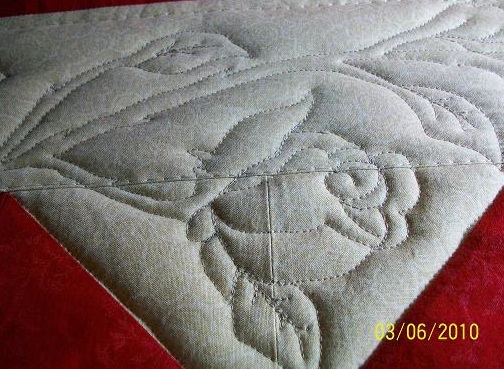We received a book for Christmas with this story. I know many of you have seen this, but it was new to me.
We received a book for Christmas with this story. I know many of you have seen this, but it was new to me.
Have you come to see what our TQS members designed for their ultimate quilt studio? Well they outdid themselves this time and it would be impossible to list all their advice. We'll give you a few tidbits here, but then you should visit here to see all kinds wonderful ideas that will make your sewing area a place to get  your creative juices flowing.
your creative juices flowing.
Here's just the tip of iceberg in sewing area hints...
A proper height cutting table.
A comfortable chair!!!
I have put wheels on all the furniture in my 20 x 20 space, giving me the flexibility to change configurations as necessary to suit the present purpose.
I'd definitely have to say a portable design wall.
Remember to consider vertical space in your area. If you have a wall use it to your best advantage. Old fashioned peg-board can be painted and then used to hang things from acrylic rulers, thread racks, etc, to packaged kits.
non-slip and easy to clean flooring, and large windows with semi-transparent blinds.
...One of the best cabinets he added was a 9" wide cabinet for cookie sheets. (She uses it to store rulers.)
DH bought insulation board and I covered it with fleece. It's an inch thick he trimmed it down to 4X5 so it would fit on the wall next to my cabinet.
My Hubby made me a pressing/cutting/storage station out of 2 sideboards. We purchased them ready made from Lowe's.
I have an old 40's ironing board that is pretty solid (not tippy). My husband made a nice topper for it that is 22" wide x 60" long. I covered it with two layers of warm and natural and a nice heavy cotton fabric.
Good lighting is a must. I used track lighting.
Photo: Carol Taylor's Quilt Studio
In January, Ruth went on a road trip to meet our Bernina 820 winner, Joan Piercy. They met at the quilt shop, Sew Original, in Boone, North Carolina and were greeted by Melinda Rose, the store owner. They were even interviewed by News Anchor Christina Cindrich who was there for Mountain Television Network. Let's take a peek and join in on the fun and excitement.
Margo gives us a GREAT lesson on how to achieve mark-less quilting designs right on her own blog! To take a lesson from Margo to get award winning results go here!

 The Dream Rocket program wants to involve students, teachers, schools, individuals, groups and organizations in a project to create over 8,000 "Dream Theme or "Visionary" panels. These will be sewn together to completely wrap a 363-foot vertical Saturn V Rocket during May and June of 2010 (for 60 days). Their aim is to connect art and education through global collaborate initiative. They want to inspire everyone to dream and to recognize their power to pursue their dreams. Themes include: Energy, Space, Peace, Science, Recycling, etc.
The Dream Rocket program wants to involve students, teachers, schools, individuals, groups and organizations in a project to create over 8,000 "Dream Theme or "Visionary" panels. These will be sewn together to completely wrap a 363-foot vertical Saturn V Rocket during May and June of 2010 (for 60 days). Their aim is to connect art and education through global collaborate initiative. They want to inspire everyone to dream and to recognize their power to pursue their dreams. Themes include: Energy, Space, Peace, Science, Recycling, etc.
Dream Rocket panels will also be displayed at various locations prior to being wrapped on the Saturn V Rocket.
Recent changes to the program allow individuals to purchase a 1 foot x 1 foot panel for only $25. This fee guarantees a spot on the rocket. Reservations for 2 foot x 2 foot and 4 foot x 4 foot panels are also available.
The other significant change to the program includes a change in the submission date. The wrapping has been rescheduled to now coincide with the 50th anniversary of JFK’s lofty challenge of “landing a man on the moon and returning him safely to earth.
For more information on the program, click here.
Dream Rocket Panel "Launch Pad to Success" by Mary Kay Davis, Sunnyvale, CA.
From January 22, 2010 through February 28, 2010 a small quilt exhibit debuted in the Sisters Art Works building in Sisters, Oregon. Entitled Elements in Cloth it featured the work of 12 Central Oregon quilt artists including: Donna Rice, Donna Cherry, Betty Gientke, Ruth Ingham, Charlene Kenny, Mary Ann Lisk, Sue McMahnon, Joanne Myers, Tonye Phillips, Robin Ryan, Mary Stiewig, and Jean Wells. We hope you enjoy this Smile Box featuring some of those artists and their wonderful contemporary works of art.
 |
Bob the Thread Guy has created an informative video on how to work with Metallic Threads. Yes, those threads that we all keep in our collection and hope someday will magically perform without breaking in our sewing machine. Just push the arrow and watch Bob as he gives you tips on how to make your metallic thread dreams come true.
Want to win some thread? Bob is giving one lucky TQS member a $50 Gift Certificate to Superior Threads.
To enter, go to metallic@thequiltshow.com and type in "Superior" in the message. Contest ends Monday, March 8, 2010 at midnight PST. So hurry!
For more information on Superior Threads just click here.
TQS Member Karlyn Bue Lohrenz, KarlynBue, is letting us take a look at her life and her quilts. Karlyn also lets us sneek a peek at her design process for one of her award-winning quilts, Calamari Time.
Karlyn was brought up on a sheep/cattle ranch near the Beartooth Mountains in Southwestern Montana and now lives in Billings. She attended Montana State University and spent most of her working years in the medical field. She began quilting in 1999. For the rest of Karlyn's story, please enjoy the video.
You had many very good questions about spray basting after viewing the first Free Motion Lesson. Patsy decided to answer those questions in her own easy to understand way. Go to the Classroom for Beg I, II, & III (Star Members only. See Membership Special Below). Intermediate Free Motion lessons are coming March 12 & March 19.
Learn this fun skill and make your quilts look amazing! We have extended the membership special.
Join for less than $20 get the Free Motion Lessons and 6 months of new shows with Alex & Ricky.
 20% Off 6 Month Membership Special
20% Off 6 Month Membership Special

You've finally talked your friend into making their first quilt. You want them to be successful; so, what block would you suggest they make?
A log cabin, an Ohio star, a four-patch? Do you have a particular pattern you think they should use?
Would you show them how to draft a block or send them straight to Alex's Start Quilting?
Submit a comment and let TQS know how you'd get that newbie up on their feet and off and running into the world of quilting.
Image from http://home2.fvcc.edu/~cgreig/final/history.html